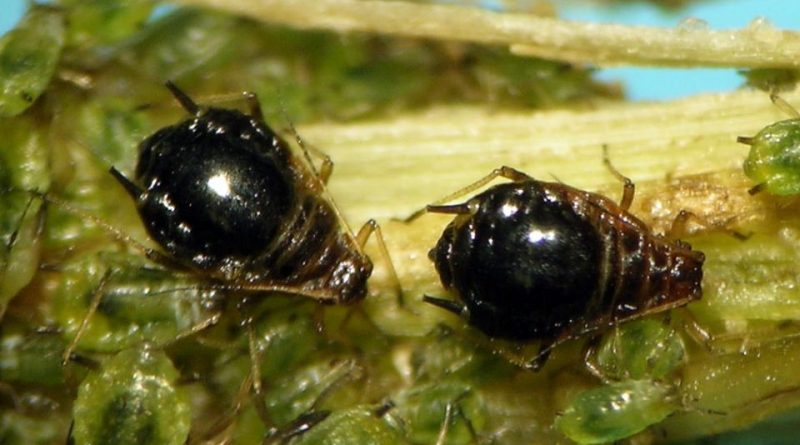Brachycaudus cardui
Brachycaudus cardui
The greenish-black aphid of the artichoke (Brachycaudus cardui L.) is a small aphid belonging to the Aphididae family.
Systematics –
From a systematic point of view, it belongs to the Eukaryota Domain, Animalia Kingdom, Subgenus Eumetazoa, Superphylum Protostomia, Phylum Arthropoda, Subphylum Hexapoda, Class Insecta, Subclass Pterygota, Exopterygota Cohort, Subcoorte Neoptera, Superorder Paraneoptera, Rhynchotoidea Section, Rhynchota Order, Suborder Homoptera, Section Sternorrhyncha, Aphidoidea superfamily, Aphididae family and therefore to the genus Brachycaudus and to the species B. cardui.
Geographical Distribution and Habitat –
Brachycaudus cardui is an aphid that has a vast distribution in various parts of the world. We find it in Europe, Asia, North Africa and North America where it lives on various plants such as: as primary guests the Cherry, the Plum and the Apricot and secondary hosts on which it migrates as: Composite such as the Artichoke, the Chrysanthemum (Chrysanthemum), the Matricaria, the Senecione (Senecio), and several Borraginaceae.
Morphology –
The Brachycaudus cardui can be recognized as the attero adult is 1.8 to 2.4 mm long; with a brownish, light green or greenish color; on the abdomen it has black dorsal spots and 2 or 3 black bands on the back. The cornicula have a black color, a thick and cylindrical shape. The rostrum is almost as long as the hind legs. It is a dioecious or heteroic species.
Attitude and biological cycle –
The greenish-black aphid of the artichoke is an insect that has as its primary guests the Cherry, the Plum and the Apricot. The migration takes place towards various Composite plants such as the Artichoke, the Chrysanthemum (Chrysanthemum), the Matricaria, the Senecione (Senecio), and several Borraginaceae. This aphid in fact carries out its cycle among plants of the genus Prunus and other herbaceous plants of the Composite families and Borraginaceae.
In southern Italy, however, this aphid presents frequent paracicles and anolyrocycles on the Composite, even the spontaneous ones (Cirsium sp.).
The Brachycaudus cardui particularly infests the Artichoke and also the Cardo where it is established, in colonies, both on the leaves, and on the axis of the flower heads or on their bracts (especially the basals); the affected organs are deformed, grow stunted and smeared with honeydew.
Furthermore, the populations of the greenish-black aphid of the artichoke are normally frequented by ants that feed on the honeydew produced by the aphids and establish a symbiotic relationship with this insect, protecting it and hunting the predators.
Ecological Role –
The infestations of the Brachycaudus cardui cause, on the affected plant parts, above all the younger leaves, wrinkles and crumplings. These colonies settle very intensely especially at the base of the flower heads and on the leaves.
Infestations are greater on intensive cultivation also due to the improper use of nitric fertilizers which tend to make the plant parts of these plants more appetizing than the aphid.
Furthermore, the excessive specialization of entire areas and the lack of vegetation that may contain predators and the idiot parasites of this aphid contribute to creating favorable conditions for biocenosis for Brachycaudus cardui.
The control of this small aphid must start from preventive conditions of agro-ecological techniques that tend to balance the present vegetation (with the presence of hedges, consociations, productive diversification, etc.) and to avoid incautious contributions of fertilizers (above all nitric) that if from one part increases the productivity of the plants, on the other they create conditions that are difficult to control infestations.
If the infestation has in any case escaped these preventive criteria, the control of the aforesaid aphids must take place in any case at the onset of the first infestations with specific aficides or with medium-wide spectrum insecticides. Also effective is the Pyrethrum Extract especially if applied at the beginning of the infestation. Also in this case we must consider the period of intervention and the presence in the area of useful and predatory insects.
Guido Bissanti
Sources
– Wikipedia, the free encyclopedia.- Russo G., 1976. Agrarian Entomology. Special Part. Liguori Editore, Naples.- Tremblay E., 1997. Applied entomology. Liguori Editore, Naples.

